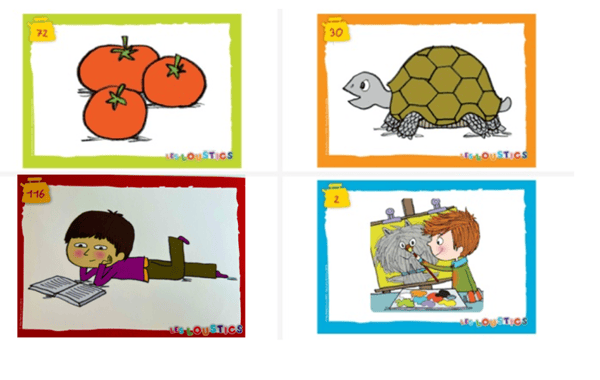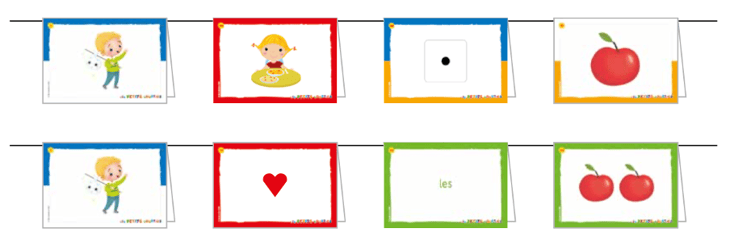Languages made easy – with index cards!
In most countries around the globe, index or flash cards are often used to teach children. However, not only do they serve the conveyance of basic concepts, they also support memorising vocabulary, dates and historical facts, and even help when learning a language.
What are flashcards?
Flashcards are index or image cards that are helpful for learning and memorising information.
Every flashcard has two sides, front and back. On the front, you write the word or paint the image for the word you want to memorise. On the back, you can write its translation or pronunciation. The flashcards I use in my classes of French as a foreign language are all cards with images and differently coloured edges. Cards with a blue edge indicate words with a masculine pronoun (e.g. «garçon» [boy]), orange is for feminine words (e.g. «tortue» [tortoise]), green signifies words in the plural (e.g. «tomates» [tomatoes]), and finally, red is for verbs (e.g. «lire» [to read]).

Why use flashcards for learning languages?
One of the keys to learning a foreign language well is to internalise as much vocabulary, verbs and expressions as possible. Equally, it is essential to learn to conjugate the verbs so entire sentences can be formed with the rest of the vocabulary. Using flashcards as a teaching method has a number of advantages for children, namely:
- They are entertaining, visual, accessible and motivating for the young learners.
- Children memorise the vocabulary more easily.
- Children develop more self-confidence when using flashcards.
What to learn?
It may be disheartening for a child to think of all the great many words they will need to learn in order to master a new language. However, luckily, they do not have to learn everything in the dictionary in one go. Here at Tandem IMS, we are using methods («Les petits Loustics» and «Les Loustics») that apportion the target vocabulary in a meaningful way and have a motivating effect on the pupils.
Moreover, the majority of language certificates, such as the First Certificate for English, the DELF for French, and the Goethe certificate for German, all prescribe a set programme for their individual certificate levels. Pupils of the respective language can thus limit their studies to the vocabulary necessary to pass each level, rather than trying to cover everything at once.
Types of flashcards for learning a language
Physical cards, made by hand:
If you opt for traditional flashcards, you and/or your child needs to have the time and motivation to cut the cards and add the images. This is not meant to discourage you from making your own flashcards, quite the contrary, it is a fun activity and makes you already memorise some of it without consciously practising. However, do not underestimate the time it takes to make them. I recommend this for flashcards in two languages.
Physical cards, downloaded and printed:
This method is a little easier and quicker. I use print-out flashcards in my regular French classes. The children can use the same cards at home – all you have to do is download the files and print them, and start playing!
Virtual:
If you are more technologically inclined, you can also install flashcard apps such as Anki or Quizlet on your computer or mobile phone. These apps are free and you can download card games to practise specific words or even create your own quiz.
Ideas for you and your child
1) Flashcards can be printed and photocopied as much as you like – it will aid some activities and even enable you to play games:
- Print 2 sets of cards so that you have two of each for a game of Memory/Pairs.
- Print 4 sets of cards to play Sudoku (4 regions).
2) Flashcards can be folded. On the back, words can be written in French and another language such as English or German.
- Ask your child to write down the corresponding words on the back of the image card.
3) Ask your child to either put into words, read out loud or write down images or words/sentences on flashcards hung on a washing line.
- Example 1: «Léon mange une pomme.»
- Example 2: «Léon aime les pommes.»

Conclusion
In summary, flashcards can improve a pupil's learning skills considerably, both at home and at school. As a pedagogical method, they motivate children to memorise new vocabulary. Moreover, the images on the cards are universal and can thus be used to learn vocabulary in any language.
Using flashcards is a valuable educational resource that captures pupils' attention and contributes to the interactive process in class. The colours support visual perception and aid the use of efficient and communicative language. Furthermore, it has been proven that colours have an influence on the mood of pupils.
The size of the flashcards is also important, as it should enable an optimal field of vision that helps gain the pupil's attention and concentration. Younger pupils will respond better to larger cards, for example A5, as these will mostly be image-based. From Primary 4 onwards, the smaller index card size (A7) with single words or phrases is more appropriate.
Have fun and success with your learning!


WRITE A COMMENT
Your email address will not be published.